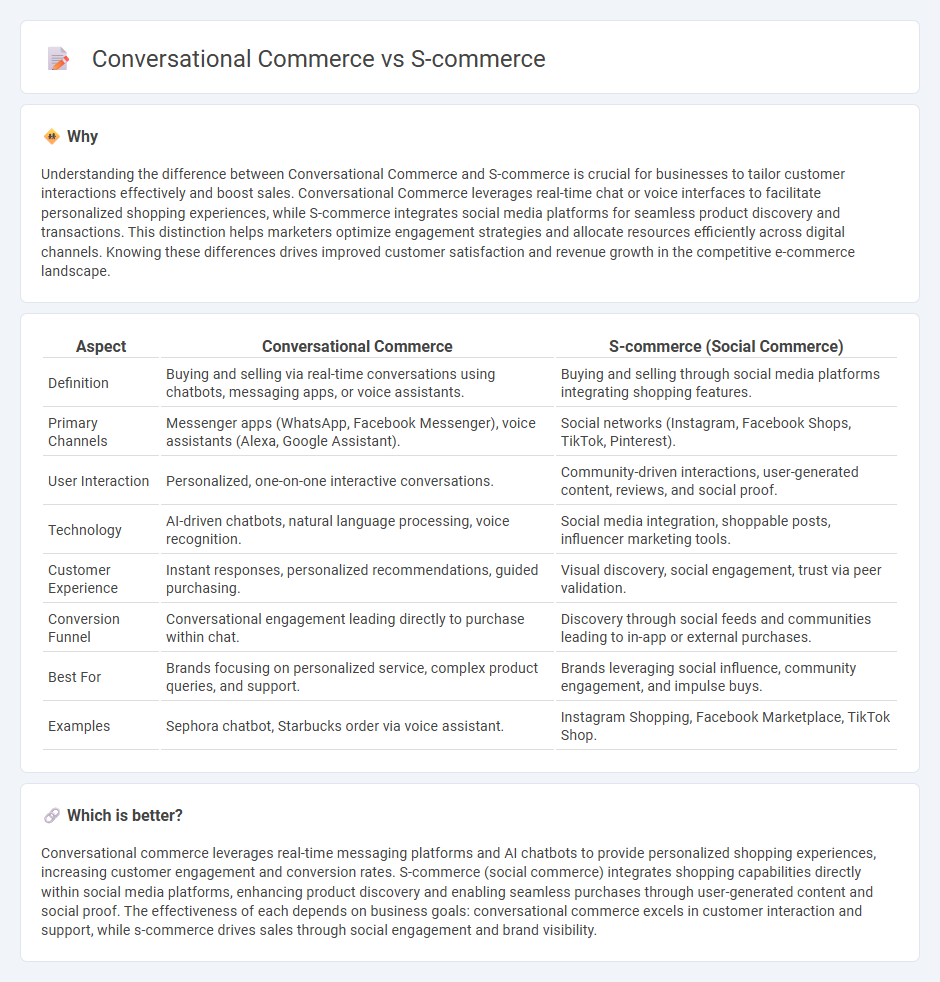
Conversational commerce leverages chatbots and messaging apps to facilitate real-time, personalized interactions between businesses and consumers, enhancing customer experience and driving sales. Social commerce (S-commerce) integrates e-commerce capabilities directly within social media platforms like Instagram and Facebook, enabling seamless shopping without leaving the app. Explore how these innovative commerce models are transforming digital retail strategies.
Why it is important
Understanding the difference between Conversational Commerce and S-commerce is crucial for businesses to tailor customer interactions effectively and boost sales. Conversational Commerce leverages real-time chat or voice interfaces to facilitate personalized shopping experiences, while S-commerce integrates social media platforms for seamless product discovery and transactions. This distinction helps marketers optimize engagement strategies and allocate resources efficiently across digital channels. Knowing these differences drives improved customer satisfaction and revenue growth in the competitive e-commerce landscape.
Comparison Table
| Aspect | Conversational Commerce | S-commerce (Social Commerce) |
|---|---|---|
| Definition | Buying and selling via real-time conversations using chatbots, messaging apps, or voice assistants. | Buying and selling through social media platforms integrating shopping features. |
| Primary Channels | Messenger apps (WhatsApp, Facebook Messenger), voice assistants (Alexa, Google Assistant). | Social networks (Instagram, Facebook Shops, TikTok, Pinterest). |
| User Interaction | Personalized, one-on-one interactive conversations. | Community-driven interactions, user-generated content, reviews, and social proof. |
| Technology | AI-driven chatbots, natural language processing, voice recognition. | Social media integration, shoppable posts, influencer marketing tools. |
| Customer Experience | Instant responses, personalized recommendations, guided purchasing. | Visual discovery, social engagement, trust via peer validation. |
| Conversion Funnel | Conversational engagement leading directly to purchase within chat. | Discovery through social feeds and communities leading to in-app or external purchases. |
| Best For | Brands focusing on personalized service, complex product queries, and support. | Brands leveraging social influence, community engagement, and impulse buys. |
| Examples | Sephora chatbot, Starbucks order via voice assistant. | Instagram Shopping, Facebook Marketplace, TikTok Shop. |
Which is better?
Conversational commerce leverages real-time messaging platforms and AI chatbots to provide personalized shopping experiences, increasing customer engagement and conversion rates. S-commerce (social commerce) integrates shopping capabilities directly within social media platforms, enhancing product discovery and enabling seamless purchases through user-generated content and social proof. The effectiveness of each depends on business goals: conversational commerce excels in customer interaction and support, while s-commerce drives sales through social engagement and brand visibility.
Connection
Conversational commerce integrates chatbots and messaging apps to facilitate instant customer interactions, while social commerce (S-commerce) leverages social media platforms for direct buying and selling. Both approaches rely on real-time communication technologies to enhance personalized shopping experiences and streamline transactions. Their connection lies in utilizing social channels and conversational interfaces to drive engagement, conversion rates, and seamless customer journeys in modern digital commerce.
Key Terms
Social Media Integration
S-commerce leverages social media platforms like Instagram, Facebook, and TikTok to enable seamless product discovery and direct purchasing within the app environment, enhancing user convenience and engagement. Conversational commerce integrates chatbots and messaging apps such as WhatsApp, Messenger, and WeChat to facilitate personalized customer interactions and real-time support during the buying process. Explore how these strategies transform digital retail by diving deeper into social media integration impacts.
Chatbots
S-commerce leverages social media platforms to facilitate seamless shopping experiences directly within apps like Instagram and Facebook, utilizing integrated chatbots to guide users through product discovery and purchasing. Conversational commerce focuses on AI-driven chatbots across multiple channels, including messaging apps and websites, enabling personalized customer interactions, real-time support, and transaction processing. Explore the evolving role of chatbots in enhancing both S-commerce and Conversational commerce strategies to drive engagement and sales.
User Engagement
S-commerce leverages social media platforms to facilitate seamless purchasing experiences through user-generated content and peer recommendations, driving high engagement rates. Conversational commerce uses AI-powered chatbots and messaging apps to create personalized interactions, enhancing customer satisfaction and increasing conversion rates. Explore how these emerging trends transform user engagement in digital shopping environments.
Source and External Links
S Commerce - Lark - S-commerce, or social commerce, integrates social media and e-commerce to allow businesses to promote, engage, and sell products directly within social platforms like Instagram and Facebook, creating immersive shopping experiences without redirecting users to external sites.
(S-Commerce) Social Commerce Influencer Marketing - GRIN - Social commerce enables consumers to shop and purchase products entirely inside social media apps, leveraging features such as ads, influencer posts, and direct checkout, thus merging social connections with shopping seamlessly.
What Is Social Commerce (S-Commerce)? | Marketing Glossary - S-commerce allows companies to sell where consumers spend most of their time--on social media--by embedding shopping directly into platforms which combine product discovery, recommendations, reviews, and purchasing in a frictionless manner within apps like TikTok, Instagram, and Facebook.
 dowidth.com
dowidth.com